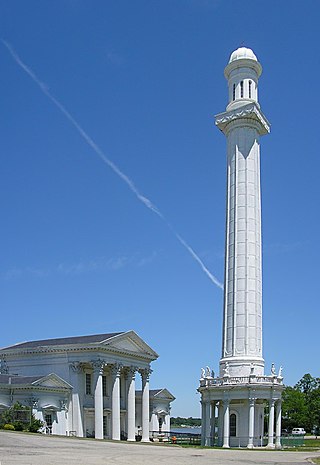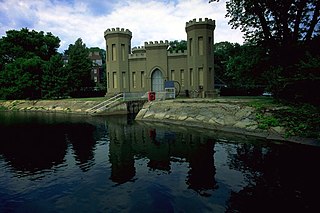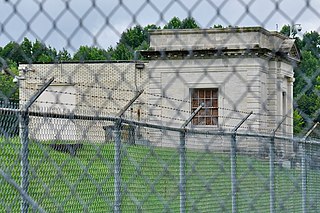
The Jerome Park Reservoir is a reservoir located in Jerome Park, a neighborhood in the North Bronx, New York City. The reservoir is surrounded by DeWitt Clinton High School, the Bronx High School of Science, Lehman College, and Walton High School.

The Margaret Mitchell House is a historic house museum located in Atlanta, Georgia. The structure was the home of author Margaret Mitchell in the early 20th century. It is located in Midtown, at 979 Crescent Avenue. Constructed by Cornelius J. Sheehan as a single-family residence in a then-fashionable section of residential Peachtree Street, the building's original address was 806 Peachtree Street. The house was known as the Crescent Apartments when Mitchell and her husband lived in Apt. 1 on the ground floor from 1925 to 1932. While living there, Mitchell wrote the bulk of her Pulitzer Prize-winning 1936 novel, Gone with the Wind.

The Louisville Water Company is a water company based in Louisville, Kentucky.

Cave Hill Cemetery is a 296-acre (1.20 km2) Victorian era National Cemetery and arboretum located at Louisville, Kentucky. Its main entrance is on Baxter Avenue and there is a secondary one on Grinstead Drive. It is the largest cemetery by area and number of burials in Louisville.

Crescent Hill is a neighborhood four miles (6 km) east of downtown Louisville, Kentucky USA. This area was originally called "Beargrass" because it sits on a ridge between two forks of Beargrass Creek. The boundaries of Crescent Hill are N Ewing Ave to the St. Matthews city limit by Brownsboro Road to Lexington Road. Frankfort Avenue generally bisects the neighborhood.

The table below includes sites listed on the National Register of Historic Places (NRHP) in Jefferson County, Kentucky except those in the following neighborhoods/districts of Louisville: Anchorage, Downtown, The Highlands, Old Louisville, Portland and the West End. Links to tables of listings in these other areas are provided below.

The Louisville Water Tower, located east of downtown Louisville, Kentucky near the riverfront, is the oldest ornamental water tower in the world, having been built before the more famous Chicago Water Tower. Both the actual water tower and its pumping station are a designated National Historic Landmark for their architecture. As with the Fairmount Water Works of Philadelphia, the industrial nature of its pumping station was disguised in the form of a Roman temple complex.

Pewee Valley Confederate Cemetery is one mile from the site of the old Kentucky Confederate Home. The cemetery is not only on the National Register of Historic Places, but an individual monument within it, the Confederate Memorial in Pewee Valley, is separately on it as part of the Civil War Monuments of Kentucky MPS. It is the only cemetery for Confederate veterans, 313 in total, that is an official state burying ground in Kentucky.

The Hackensack Water Company Complex is a set of historic buildings in Weehawken, New Jersey, registered in the U.S. National Register of Historic Places. The Hackensack Water Company, a predecessor of Suez North America, developed water supply and storage in northeastern New Jersey from the 1870s to the 1970s, initially to provide service to the city of Hackensack and the towns of North Hudson. Originally its headquarters and major facilities were located at Hackensack, in Bergen County. Under Robert W. de Forest, who ran the Hackensack Water Company for 46 years beginning in 1881, the company constructed new facilities and moved its headquarters to Weehawken in Hudson County, setting up offices in a brick water tower, part of the present complex.

The Framingham Reservoir No. 1 Dam and Gatehouse is a historic water works facility in Framingham, Massachusetts. This complex is located at the end of Framingham Reservoir No. 1, which is also known as the Stearns Reservoir, off Winter Street and north of Long Avenue. Constructed from 1876 to 1878 as part of an expansion of the water supply of the city of Boston, this was designed by its first city architect George A. Clough. The historical purpose of the reservoir, which was located at the confluence of two branches of the Sudbury River, was primarily to control the river's water level, and secondarily to provide reserve supply capacity. The reservoir's reserve capacity was generally used only as a backup supply, as the reservoir's muddy bottom made it a less desirable source than reservoir No. 3 upstream. However the reservoir No. 1 system was nonetheless important due to its role in controlling the flow of the river downstream, and due to the gatehouse which controlled the water flows for all the Framingham reservoirs into the Sudbury Aqueduct. Reservoir No. 1 is no longer maintained as a reserve water source, although it is still owned by the Massachusetts Water Resources Authority, successor to the Boston Water Board which oversaw its construction. MWRA retains ownership as the gatehouse contains the connection between Reservoir No. 3 and the Sudbury Aqueudct which remain part of the emergency water systems.

The Middlesex Fells Reservoirs Historic District is a historic district roughly bounded by Pond St., Woodland Rd., I-93, and MA 28 in Stoneham and Medford, Massachusetts. It encompasses a portion of the Middlesex Fells Reservation, a state park managed by the Massachusetts Department of Conservation and Recreation (DCR). The principal features of the district are three reservoirs and their associated gate houses and pumping stations, which were developed by the Metropolitan District Commission starting in the late 19th century. The district was listed on the National Register of Historic Places in 1990.

The Fisher Hill Reservoir and Gatehouse are historic elements of the public water supply for the Greater Boston area.

Castle Gatehouse, Washington Aqueduct is a pumping station at the Georgetown Reservoir on the Washington Aqueduct in The Palisades neighborhood of Washington, D.C., United States. The building is on the National Register of Historic Places and contributes to the Washington Aqueduct National Historic Landmark.

Cardinal Hill Reservoir is a historic site in Jefferson County, Kentucky. It is listed on the National Register of Historic Places. It was designed by Chicago architect Victor Andre Matteson. A one-story structure of stone (ashlar), it includes Doric pilasters, full entablature, parapet wall, shouldered architraves, quoins, and balustraded stairs. Lights along front bank of old reservoir set on pedestal bases "with tomb-like structures" holding lights at corners.
Charles Hermany was an engineer and architect.
Louisville WaterWorks Museum opened in the west wing of a renovated and restored interior of Pumping Station No. 1 on Zorn Avenue at 3005 River Road in Louisville, Kentucky overlooking the Ohio River. The building was constructed from 1858 until 1860 as part of Louisville's original water works. It was listed as a National Historic Landmark in 1971.

The Monroe Avenue Water Filtration Plant is a municipal water treatment plant located at 430 Monroe Avenue NW in Grand Rapids, Michigan. Built in 1910, it was likely the first water filtration plant in Michigan. In 1945, the plant was the site of the first public introduction of water fluoridation in the United States. It was listed on the National Register of Historic Places in 2002. The building now serves as an event center, known as Clearwater Place.

Omohundro Water Treatment Plant is a municipal water treatment plant located in Davidson County, Nashville, Tennessee on Omohundro Drive.

Eighth Avenue South Reservoir is a man-made masonry reservoir in Nashville, Tennessee. The reservoir was built on Kirkpatrick's Hill which was the former site of Fort Casino: a Union Army fort in the American Civil War. Completed in 1889, it ruptured in 1912 causing much property damage, and was repaired in 1914. In 1978, it was listed on the National Register of Historic Places listings in Davidson County, Tennessee (NRHP). The reservoir is the largest and oldest working reservoir supplying water to the city of Nashville, and remains in use as of 2022.


















